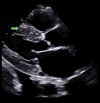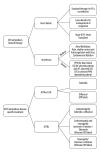Navigating Diagnostic Ambiguities in Cardiac Amyloidosis: Insights from a Case with Delayed Diagnosis of AL Amyloidosis
- PMID: 40611504
- PMCID: PMC12236112
- DOI: 10.12659/AJCR.948092
Navigating Diagnostic Ambiguities in Cardiac Amyloidosis: Insights from a Case with Delayed Diagnosis of AL Amyloidosis
Abstract
BACKGROUND Cardiac amyloidosis is the accumulation of aberrant proteins in the heart, liver, brain, and several other organs. It presents both extracardiac and cardiac symptoms, making diagnosis difficult and early detection crucial in the prognosis of the patient. Diagnostic techniques for cardiac amyloidosis can present false-negative results, making diagnosis difficult in the early stage of the disease. CASE REPORT A 67-year-old man presented for worsening dyspnea of several months' duration and recent cough. Echocardiography study showed unexplained biventricular hypertrophy with preserved left ventricular systolic function, and a restrictive filling pattern suggesting an infiltrative heart disease like cardiac amyloidosis. Technetium pyrophosphate scan, light-chain assay, and serum and urine protein immunofixation were negative. The patient was treated as a case of advanced heart failure, with initial improvement. He started deteriorating progressively, and repeating the workup was considered. Six months later, a repeated echocardiogram showed severely impaired left ventricular systolic function and findings suggestive of advanced cardiac amyloidosis. Free light-chain assay was positive, in favor for AL amyloidosis, which was confirmed by a bone marrow biopsy and cardiac MRI. Chemotherapy was started, but the patient died due to stage D heart failure caused by advanced AL amyloidosis. CONCLUSIONS We aim at increasing awareness of the early diagnosis of cardiac amyloidosis and highlighting the importance of considering the disease even with an initial negative workup. We will also try to explain the reason for the false-negative initial workup and to implement the use of cardiac MRI in early stages if the clinical suspicion for the disease is high.
Conflict of interest statement
Figures








Similar articles
-
Multimodality imaging features of systemic amyloidosis: a case report.BMC Cardiovasc Disord. 2025 Jan 2;25(1):1. doi: 10.1186/s12872-024-04441-6. BMC Cardiovasc Disord. 2025. PMID: 39748274 Free PMC article.
-
Amyloid Light-Chain (AL) Amyloidosis in a Middle-Aged Lady: Confronting the Challenges of a Rare Diagnosis in a Developing Country.Cureus. 2025 Jun 7;17(6):e85493. doi: 10.7759/cureus.85493. eCollection 2025 Jun. Cureus. 2025. PMID: 40630347 Free PMC article.
-
Doppler trans-thoracic echocardiography for detection of pulmonary hypertension in adults.Cochrane Database Syst Rev. 2022 May 9;5(5):CD012809. doi: 10.1002/14651858.CD012809.pub2. Cochrane Database Syst Rev. 2022. PMID: 35532166 Free PMC article.
-
Signs and symptoms to determine if a patient presenting in primary care or hospital outpatient settings has COVID-19.Cochrane Database Syst Rev. 2022 May 20;5(5):CD013665. doi: 10.1002/14651858.CD013665.pub3. Cochrane Database Syst Rev. 2022. PMID: 35593186 Free PMC article.
-
An atypical cause of amyloidosis: a case of combined heavy and light chain amyloidosis.BMC Nephrol. 2025 Jul 1;26(1):332. doi: 10.1186/s12882-025-04226-9. BMC Nephrol. 2025. PMID: 40597878 Free PMC article.
References
Publication types
MeSH terms
LinkOut - more resources
Full Text Sources
Medical

